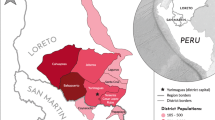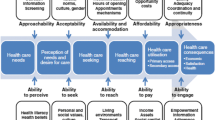Abstract
Traditional, complementary and alternative medicine (or heterodox health care) functions as the primary source of health care for a majority of populations in low-income countries. The World Health Organization has promoted the integration of heterodox health-care practices and practitioners into formal state and local biomedical health-care systems. Heretofore, the literature has assumed the beneficence of this policy in reducing health-care disparity, without assessing the outcomes of this policy’s implementation. This research examines the impact of health-care integration policy on local health care in communities in four municipalities in the Philippines. Communities in two municipalities that implemented health-care integration (top-down and bottom-up) were compared with two municipalities that did not implement health-care integration. A qualitative design of data collection was utilised. Convenience samples (n=500) of community members, community leaders, health-care providers and key policy actors participated in semi-structured interviews and focus groups to assess the changes in community health-care systems and in community health-care access following health-care integration. The assumptions of beneficence of health-care integration are not supported by this research. Furthermore, this research suggests that health-care integration may not be beneficial to communities if implemented in a manner that ignores the particular needs of a given local context.
Similar content being viewed by others
References
Asian Development Bank. (2007) Philippines: Women’s Health and Safe Motherhood Project Performance Evaluation Report, http://www.adb.org/Documents/PPERs/PHI/27010/27010-PHI-PPER.pdf, accessed 5 January 2010.
Bala, P. (2007) Medicine and Medical Policies in India: Social and Historical Perspectives. Lanham, MD: Lexington.
Bautista, V. (1999) A State-of-the-Art Review of Primary Health Care in the Philippines. Two Decades of Government Initiative. Manila, Phillipines: Republic of the Philippines Department of Health.
Bautista, V., Leagspi, P., Santiago, E. and Juan, L. (2002) National and Local Government Roles in Public Health under Devolution. Manila, Phillipines: University of the Philippines Press.
Bello, W. (2009) The Anti-development State: The Political Economy of Permanent Crisis in the Philippines. Pasig City: Anvil.
Bergström, F. and Goodburn, E. (2001) The role of traditional birth attendants in the reduction of maternal mortality. Studies in HSO&P 17: 77–96.
Birn, A. (2005) Chinese Barefoot Doctors, A Viable Model Today?. Working Paper IDSC 11. Stian Haklev.
Bodeker, G. and Burford, G. (2007) Traditional Complementary and Alternative Medicine: Policy and Public Health Perspectives. London: Imperial College Press.
Cheng, M. (2010) Lancet: Sharp drop in maternal deaths worldwide. Associated Press, http://www.newsvine.com/_news/2010/04/13/4156796-lancet-sharp-drop-inmaternaldeaths-worldwide, accessed 13 April 2010.
Dauskardt, R.P.A. (1990) Traditional medicine: Perspectives and policies in health care development. Development Southern Africa 7 (3): 351–358.
Department of Health of the Republic of the Philippines. (2008) Administrative Order 2008-002. Implementing Health Reforms for Rapid Reduction of Maternal and Neonatal Mortality.
European Commission. (2008) Mid-term review of the health sector policy support programme (ASIE/2005/017638) in the Philippines. Commission of the European Communities.
Grady, D. (2010) Maternal deaths decline sharply across the globe. New York Times 13 April 2010, http://www.nytimes.com/2010/04/14/health/14births.html, accessed 13 April 2010.
Hogan, M. et al (2010) Maternal mortality for 181 countries, 1980–2008: A systematic analysis of progress towards Millennium Development Goal 5. Lancet 375 (9726): 1609–1623.
Jocano, L. (2004) Folk Medicine in a Philippine Municipality: An Analysis of the System of Folk Healing in Bay, Laguna, and Its Implications for the Introduction of Modern Medicine. Manila, Phillipines: Tamarind.
Kadetz, P. (2009) WHO-Western Pacific Regional Office Report on the State of Traditional, Complementary, and Alternative Medicine in the Philippines: A Pilot Study of the WPRO 2002–2010 Strategic Objectives. Manila: World Health Organization. Technical Report.
Kadetz, P. (2010) Assessment of the Current State of Traditional Medicine in the Western Pacific. In Report of Meeting for Future Directions for Traditional Medicine in the Western Pacific Region. Manila: World Health Organization.
Kruske, S. and Barclay, L. (2004) Effect of shifting policies on traditional birth attendant training. Journal of Midwifery & Women’s Health 49 (4): 306–311.
Lantum, D.N. (2007) The Place of Policy in Applied Health Care and Technology with Special Reference to African Traditional Medicine. ATPS Special Paper Series No. 31. Nairobi: African Technology Policy Studies Network.
Leslie, C. (1992) Interpretations of illness: Syncretism in modern ayurveda. In: C. Leslie and A. Young (eds.) Paths to Asian Medical Knowledge. Berkeley, CA: University of California Press.
Lucas, A. (1982) Chinese Medical Modernization: Comparative Policy Continuities 1930s–1980s. New York: Praeger.
Mendoza, R.L. (2009) Is it really medicine? The Traditional and Alternative Medicine Act and informal health economy in the Philippines. Asia-Pacific Journal of Public Health 20 (10): 1–13.
National Statistics Office, Republic of the Philippines. (2008) http://www.census.gov.ph/data/sectordata/datapop.html, accessed 2 January 2009.
Oxman, A. (2007) Use of evidence in the WHO recommendations. The Lancet 369 (9576): 1883–1889.
Penwell, V. (2009) Mercy in action. Bringing mother- and baby-friendly birth centers to the Philippines. In: R. Davis Floyd, L. Barclay, B.A. Davis and J. Tritten (eds.) Birth Models that Work. Berkeley, CA: University of California Press.
PITAHC. (2009) http://doh.gov.ph/pitahc/Index.html, accessed 10 October 2009.
Pricewaterhousecoopers. (2009) Investing in China's pharmaceutical industry, http://www.pwc.com/en_GX/gx/pharma-life-sciences/assets/en-pharma_03-26-small.pdf, accessed 15 October 2010.
Rajaratnam, J.K., et al. (2010) Neonatal, postneonatal, childhood, and under-5 mortality for 187 countries, 1970–2010: A systematic analysis of progress towards Millennium Development Goal 4. Lancet 375 (9736): 1988–2008.
Republic of the Philippines. (1997) Republic Act no. 8423; The Traditional and Alternative Medicine Act.
Rosenthal, M. (1981) Political process and the integration of traditional and western medicine in the People’s Republic of China. Social Science and Medicine 15 (5): 599–613.
Tan, M. (1987) Traditional Concepts of Health and Illness in the Philippines. Quezon City, Phillipines: AKAP.
Tan, M., Querubin, M. and Rillota, T. (1988) The integration of traditional medicine among community-based health programmes in the Philippines. Journal of Tropical Pediatrics 34: 71–74.
USAID. (2004) Newborn Health in the Philippines: A Situation Analysis, Basics Support for Institutionalizing Child Survival Project (BASICS II) Arlington, VA: United States Agency for International Development.
Walraven, G. and Weeks, A. (1999) The role of traditional birth attendants with midwifery skills in the reduction of maternal mortality. Tropical Medicine and International Health 4 (8): 527–529.
Walt, G. (1994) Health Policy: An Introduction to Process and Power. London: Zed Books.
World Health Organization. (1978) Declaration of Alma Ata. Geneva: WHO, http://www.paho.org/English/DD/PIN/alma-ata_declaration.htm.
World Health Organization. (1992) Traditional Birth Attendants – A Joint WHO/UNFPA/MCH Statement. Geneva: WHO.
World Health Organization. (2002) Regional Strategy for Traditional Medicine in the Western Pacific 2002–2010. Manila, Phillipines: the WHO Regional Office for the Western Pacific.
Author information
Authors and Affiliations
Rights and permissions
About this article
Cite this article
Kadetz, P. Assumptions of global beneficence: Health-care disparity, the WHO and the outcomes of integrative health-care policy at local levels in the Philippines. BioSocieties 6, 88–105 (2011). https://doi.org/10.1057/biosoc.2010.43
Published:
Issue Date:
DOI: https://doi.org/10.1057/biosoc.2010.43




